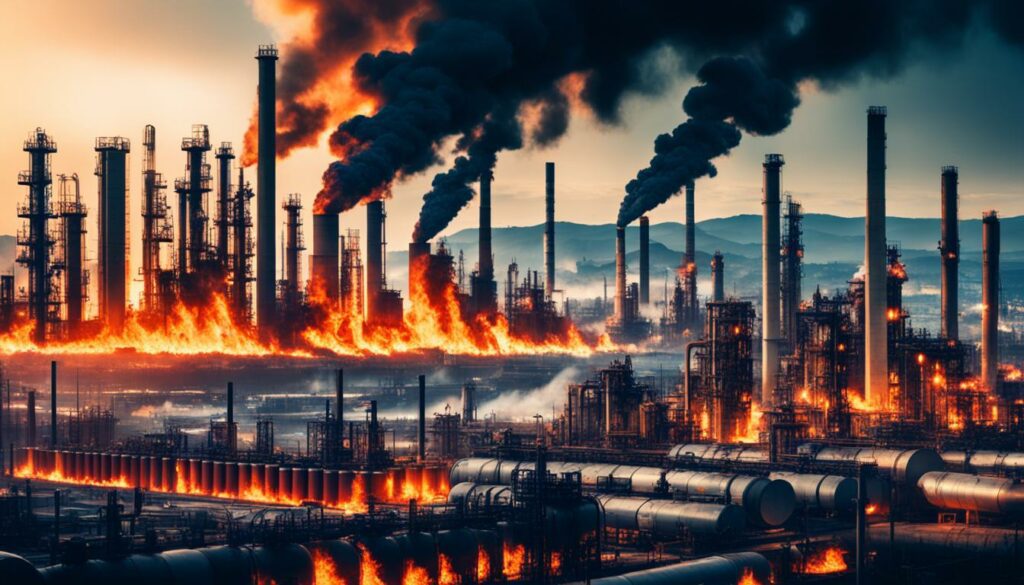Menu

Did you know the real GDP growth could fall to just 0.7% in 2024 from 2.8% in 2023? This big drop will have a major impact on commodity price trends 2024. It makes us look closer at the economy and how it affects these markets.
My work on the market trends research for 2024’s commodities comes from S&P Global Commodity Insights. Their reports and workshops are very insightful. They help us see what might happen in the market. The “Commodities outlook 2024” report was especially useful in knowing how key commodities will act soon.
Plus, the World Bank’s “Pink Sheet” data has been crucial. It gives a strong history lesson, making my predictions on next year’s commodity price trends better.
The 2024 commodity prices are the focus of many detailed analyses from various sources. Knowing these trends well is key for dealing with our changing economic world.
S&P Global’s findings highlight key commodities for 2024. Base metals and soft commodities are key, affecting overall market directions. The “Commodities outlook 2024” report underlines their importance.
The May 2024 “Commodity Markets Outlook” by the World Bank sheds light on market conditions. It stresses knowing these trends helps predict future prices and adjust strategies. Understanding market trends aids in making better economic decisions and staying strong against market changes.
| Category | Predicted Price Change in 2024 |
|---|---|
| All Food Prices | 2.2% |
| Food-at-home Prices | 1.2% |
| Food-away-from-home Prices | 4.2% |
| Dairy Products | -1.6% |
| Poultry | 1.6% |
| Fish and Seafood | -1.6% |
| Beef and Veal | 3.3% |
| Pork | 0% |
| Eggs | 4.8% |
| Fats and Oils | 2.2% |
| Sugar and Sweets | 4.3% |
| Cereals and Bakery Products | 0.1% |
| Fresh Fruits | 0.4% |
| Fresh Vegetables | 1.1% |
Combining these detailed insights helps businesses and leaders handle the changing commodity market. This approach supports stable and growing economies despite global market shifts.
Geopolitical issues affect commodity trading in 2024. They often cause changes in commodity prices. For example, problems in big energy-producing areas can make prices jump up and down.

When fights happen in certain regions, commodity prices can change. The Middle East is a key area for this. Problems there can make energy prices go up, affecting things like oil. In early April, oil prices jumped above US$91 per barrel. This was mostly due to the troubles in this region.
In 2024, energy prices are expected to stay shaky because of these tensions. For instance, Brent crude oil prices might hit an average of $92 per barrel. At the same time, natural gas prices recently dropped, almost 40% lower than before.
Conflicts can also shake up the metal markets. Recently, copper hit a two-year high and gold reached record prices in April. The demand from developing countries and global events can affect the prices of these metals. This makes predicting the metal market tricky.
Supply chains worldwide are facing big challenges today. Geopolitical issues only make these problems worse. The Middle East’s conflicts are a prime example. Problems there can impact everything from energy to farm products.
But, not all news is bad. OPEC+ countries are expected to increase their supply this year. This could balance out some of the ups and downs in prices. In fact, energy prices have already dropped by 3% since January.
| Commodity | Price Trends 2024 | Geopolitical Influence |
|---|---|---|
| Brent Crude Oil | Slight Decline, average $84/bbl | Middle East conflicts, Supply disruptions |
| Natural Gas | 40% lower compared to the previous year | Energy supply stability, Regional tensions |
| Gold | Record highs anticipated | Central bank demand, Geopolitical uncertainties |
| Copper | 5% rise expected | Market instability, Conflict-driven gains |
| Agriculture | Expected ease in prices | Global supply chains, Weather-related disruptions |
Understanding how geopolitics affect markets is key in 2024. By knowing the risks and trends, we can make better predictions. The link between fights, supply chains, and market changes gives us valuable insights. This helps stakeholders plan for challenges and growth opportunities.
The uranium market is set for big changes in 2024. It’s mainly because of geopolitics and how much uranium is needed. It’s key for those involved to know the key points that shape the market.
Recent times have seen geopolitics play a big part in the uranium market. Russia, the world’s sixth biggest uranium producer, is a big player. Worries over its supply have made the market uncertain. Political tensions in Niger and Kazakhstan are also adding to this uncertainty.
The Sprott Physical Uranium Trust could raise prices in 2024. Its effects show how big political actions can be on the market.
The uranium market’s supply and demand situation will make a big difference in 2024. There is more demand for uranium fuel worldwide. This is because around 440 nuclear reactors are operating, with more being made and planned.
By 2040, the world might need nearly twice as much uranium for reactors as in 2023. This is all part of efforts to be more sustainable. But, keeping up with the demand is hard. This is because of rules and old problems with knowing the market well.
Companies like NexGen Energy and Fission Uranium could do well. ETFs like Global X Uranium ETF and Sprott Uranium Miners ETF make it easier to invest. They help to deal with the ups and downs of the market better.
Investing in exploration companies might bring big wins but is also risky. Doing your homework is a must. With geopolitics making things more complicated, spreading investments in different areas and projects is smart.
To sum up, the uranium market in 2024 is closely linked to global politics and the need for a good balance in how much is available and wanted. Knowing all the facts and planning smartly will help investors gain from the new chances and trends.
Base metals like copper, tin, and aluminium are greatly affected by the push for cleaner industries. This comes from both strict environmental rules and how much metal companies need. These factors will likely cause prices to change a lot.

Copper’s price could go up to $8,900 a tonne by 2024. This is a 5% increase over the previous year. There might be a short supply, affecting around 0.5% of the world’s want for it. Tin might also climb up by 4%, with a projected price of $27,040 a tonne.
But, not all prices are rising. Aluminium’s cost could drop by 1.6%, making it $2,212 a tonne. Zinc might be cheaper by 6.5%, with a forecasted price of $2,471 a tonne. The price of lead is also expected to go down by 5.4%, reaching $2,022 per tonne in 2024.
The nickel market might see a big fall, reaching $16,775 a tonne. This is 22% less than in 2023. A lot of nickel might sit around unused, making up about 5.1% of the market in 2024.
Decarbonising industries also make the metal market harder to predict. Deloitte talks about how using local materials, creating community energy, and picking smart project sites can help the industry guess what to expect. This could lead to more people wanting these metals and different ways to invest in them.
| Metal | 2024 Price Forecast ($ per tonne) | Percentage Change from 2023 |
|---|---|---|
| Copper | $8,900 | 5% increase |
| Tin | $27,040 | 4% increase |
| Aluminium | $2,212 | 1.6% decrease |
| Zinc | $2,471 | 6.5% decrease |
| Lead | $2,022 | 5.4% decrease |
| Nickel | $16,775 | 22% decrease |
To understand the Asian LSFO market, we need to look deep into its future. S&P Global insights show a big supply but low demand. This balance may change a lot by 2024.
DNV’s Alternative Fuel Insights shows scrubber ships will grow by 6% to 5,095 in 2023. In 2024, this number will keep rising. The Hi-5 spread, a key price difference, has reduced by 13% in a year. Platts thinks this is important.
In 2024, China can import 20 million mt of fuel oil, which is more than 2023. HSFO sales in Singapore grew by 17.6% in the first 11 months of 2023. This rise, to 14.91 million mt, beats the 2022 sales of 13.99 million mt.
More HSFO was also sold in Zhoushan, growing from 20% to 25%-35% of all sales. S&P Global thinks Asia’s overall fuel oil need will grow by 34,000 b/d in 2024 and 4,000 b/d in 2025. Over 70% of this will be for bunker fuel.
These details show we need a focused look at the market. Instead of broad reports like “Commodities outlook 2024”, we should do detailed studies. A close look at the region will give us better predictions for the Asian LSFO market.
China is changing its carbon market in big ways. The price to trade China Emission Allowances (CEAs) hit Yuan 68.15/mtCO2e ($9.62/mtCO2e) in 2023. This was up by 23.24% from the year before, showing the markets are evolving rapidly.

In 2024, the China Certified Emission Reduction (CCER) market will be back after six years. Now, seven new sectors have to report their yearly emissions. This will make the need for carbon allowances even higher.
They are also starting to sell different types of CEAs in Shanghai. And, companies need the MEE’s approval to trade, adding more clarity to how the market works. The State Council’s rules aim to keep trading fair and fine those who don’t play by the rules. This will help keep the market steady.
Trade for CEAs jumped to 212 million mtCO2e in 2023, up 316%. This shows a growing market well-adjusted to new rules.
In 2024, more sectors like cement, aluminium, and others will join. They must follow strict emission rules. The MEE has also set out new ways to earn CCERs, like planting trees or using wind energy. This means there are more ways to help lower emissions.
But, when it comes to Article 6, China is waiting for clear rules from the UN. This might slow market changes a bit. But, it also puts China in a good spot to lead once there’s a clear plan.
So, things are looking up for China’s carbon market. This will be important for how trading in emissions happens around the world.
For more insights on China’s carbon market, check out S&P Global’s detailed analysis.
When we look at commodity price trends 2024, we see many big changes ahead. These changes are likely to affect market players a lot. I’ve gathered useful data from S&P Global and by studying market trends closely.
From mid-2022 to mid-2023, global commodity prices fell a lot, by almost 40%. But, economic trends analysis shows these prices will stay about 38% higher than before the COVID-19 pandemic.
The World Bank expects commodity prices to drop by 3% in 2024 and 4% in 2025. They think Brent crude oil will cost around $84 per barrel in 2024, then $79 in 2025. But if there are issues with supply because of conflicts, prices could go up a lot. They might even jump to over $100 a barrel. This could raise inflation by nearly one percentage point in 2024.
In 2024, gold prices could reach all-time highs, then drop a bit in 2025. Food prices are predicted to fall by 6% and another 4% the following year. Also, fertiliser prices may drop by 22% in 2024 and 6% in 2025.
Copper prices are set to go up by 5% in 2024 and stay the same in 2025. Aluminium’s price should increase by 2% in 2024 and 4% in 2025. It’s important to keep an eye on these changes. They will affect the market significantly.
A deep look into the World Bank’s April 2024 forecasts shows how vital these insights are. They can help us understand and maneuver through the complex world of commodity markets in the coming year.
| Commodity | 2024 Price Forecast | 2025 Price Forecast |
|---|---|---|
| Brent Crude Oil | $84 per barrel | $79 per barrel |
| Gold | Record High | Moderated |
| Copper | +5% | Stabilized |
| Aluminum | +2% | +4% |
| Food Prices | -6% | -4% |
| Fertilizer Prices | -22% | -6% |
Analyzing this economic trends analysis helps stakeholders prepare for what’s to come in 2024. By understanding the commodity price trends 2024 in detail, they can be ready for both challenges and opportunities.
In 2024, we expect big changes in the tanker freight market. This is mainly because there will be fewer ships available and trade routes will be longer. The slowdown in global trade by the end of 2022 and the modest growth expected in 2023-24 make the tanker sector very interesting.

The current and future freight rates are influenced by several key factors. There’s a big drop in the number of new ships being added. In 2024, only two new big tankers are expected, a huge drop from the usual number. So, there will be far fewer ships than usual.
This tight ship supply is happening at the same time that oil trade, especially within Asia, is increasing. This results in longer journeys for ships, contributing to about a 3% increase in the total distance travelled by ships over the sea.
Other factors include geopolitical issues and changes in oil trade flows. For example, there are less Russian oil exports to Europe, which means ships are travelling further. This benefits certain types of tankers. The demand for shipping oil products is expected to grow over 2%, leading to a strong market. By the middle of 2023, it’s estimated that a tanker could make around $40,000 a day, showing a growing need for ships.
The way trade flows are changing because of longer voyages is especially affecting Europe and its imports of Russian crude oil. Before, Europe got about four million barrels a day from Russia. This has dropped a lot since the conflict, with about 700,000 barrels less each day being shipped short distances.
Now, ships have to take longer routes, making certain routes more appealing for specific tanker ships. This change has meant more work for some types of tankers. Their use has gone up by about 5%, showing how important these shifts are for the tanker market.
Looking ahead, the tanker market is set to do well. The low number of new orders for ships, an ageing ship fleet, and strict environmental rules are seen as positive. This means good times could be coming for those in the tanker business soon.
Brazil’s oil and gas industry is looking towards a bright future. It’s because of big investments and goals for clean, sustainable energy. The market’s performance from 2018 to 2028 looks really promising.
Brazil is shifting towards cleaner energy. This change is making its oil and gas sector evolve. The country is encouraging new exploration and production with better rules and economic support.
The plan was to produce more natural gas, but this faced some delays. Still, there’s a positive vibe overall, driven by smart plans and more demand for liquid fuels.
Investing in new projects is essential for the sector’s growth. Big companies like Shell Brasil and Chevron Brasil have a big role. They are helping the market grow more. By 2025, there will be a 3.0% increase in the need for liquid fuels, showing solid growth.
Across the world, places like North America and Asia offer chances for growth. The way technology is changing, what people want, and the laws are affecting Brazil’s oil and gas scene.
The voluntary carbon market is experiencing many changes now. This includes big variations in price forecast commodities and changes in the trading outlook. In 2023, the market saw a drop in carbon credit prices, making investors worry. This has also made it harder for projects to get money. Despite these tough times, we see signs that the market might improve and change in the future.
In California, the average carbon price could be $42 per metric ton in 2024. That’s up from $34 per ton in 2023. This shows how committed the state is to fight climate change. It might also be a sign of good things to come for the voluntary carbon market. The EU expects its carbon prices to be about €71 per ton ($76 per ton) in 2024. This is less than the €85 per ton in 2023. These changes highlight how the price forecast commodities market is always moving. But, the plan is to reach €149 per ton by 2030.

When we look at carbon offsets, something interesting is happening. The gap between the compliance and voluntary carbon markets is getting smaller. This is because governments are pushing harder for net-zero emissions. For example, a carbon offset credit could cost $13 per ton by 2030. If everyone agrees on high standards, this price might go up to $20 per ton. This shows how rules can really change the trading outlook.
There are also new markets and plans for growth. Like, linking Washington and California or New York’s scheme to limit and reinvest. Also, more players joining in places like South Korea. The EU is using new technology to capture air pollutants directly. This is a big step in their carbon reduction efforts.
Next, the EU power sector is in for big changes. There’s going to be too many emission allowances for shipping in 2024-25. But, by 2026, there might not be enough. This adds more twists to the price forecast commodities story.
Here are specific projections:
| Region/Market | 2023 Price | 2024 Price | 2030 Projection |
|---|---|---|---|
| California | $34/ton | $42/ton | $93/ton |
| EU | €85/ton | €71/ton | €149/ton |
| Carbon Offsets | $13/ton | N/A | $146/ton (with direct air capture) |
The idea of “carbon nationalism” will probably affect future policies. Many countries want to promote making carbon offsets at home. This is alongside work from groups like the Science Based Targets initiative and the Voluntary Carbon Markets Integrity Initiative. Such efforts show how standard rules and working together are really important for the voluntary carbon market.
In 2023, the Indian rice export market saw big changes. This was mostly due to risks in policies and rising prices. The Indian government put bans and taxes on exporting rice to keep the local supply stable. They thought these actions would last until 2024. Because of this, traders think there will be limits on exports until the first part of next year.
Forecasts suggest the industry faces tough times. Rice production in India is expected to drop to 128 million metric tons from 135.5 million. Despite these actions, the cost of rice at home has stayed high. This has made many worried and expects prices to stay high till the next harvest. Exporters are concerned about keeping their prices competitive worldwide.
Big markets like West Africa, who often buy from India, might buy less due to the higher prices. Even the demand for special Basmati rice could slow down. This is because moving it costs more and there is a minimum price of $950 per metric ton set for exports in 2023. Yet, there is hope. India has a lot of rice in storage. The Food Corporation of India says they have 56 million metric tons in reserve. This is 15% more than last year. It might mean they can export more later.
With these shifts happening, those in the Indian rice export business need to stay alert and ready to change. They should also get ready to take advantage if the export rules lighten.
| Metrics | 2022-23 | 2023-24 (Forecast) |
|---|---|---|
| Total Rice Production (million mt) | 135.5 | 128 |
| Rice Stocks in FCI Central Pool (million mt) | 48.7 | 56 |
| Milled Rice Stocks (million mt) | 11.6 | 18.4 |
| Paddy Stocks (million mt) | 37.1 | 37.6 |
To predict the future of Indian rice exports, it’s crucial to grasp the market challenges and global market trends.
In the first half of 2024, the chemical industry faces challenges. The China property sector and India’s economy are key influencers. They affect demand, production, and how the market behaves.

The China property sector plays a big role in chemical trends. As the construction industry slows down, the need for chemicals like PE and PS drops. This situation has led to an expected oversupply in Latin America’s PE markets for 2024.
Over the last five years, PE demand went up by 15.2%. However, there was a 26.1% increase in capacity. This mismatch has created an oversupply issue.
On the other hand, India’s economy is a key player. Despite a manufacturing slowdown, the future looks positive. There’s a hope for demand rises in products like butyl acetate and glycol ethers, with potential rate cuts making things optimistic.
India’s situation might also positively affect US chemical companies. Controlled inflation and lower interest rates could boost their stock performance.
The new year begins with an optimistic outlook for US chemical companies’ shares, driven by expectations of controlled inflation and the possibility of rate cuts.
The first half of 2024 will be shaped by China’s property sector and India’s economy. It’s vital for market participants to keep an eye on these factors. By doing so, they can adjust their strategies and capitalise on new possibilities.
El Niño, a big weather phenomenon, will strongly impact the soft commodities market. This will happen by affecting how much food is made and by changing the prices of these products. I looked into detailed reports and research to understand how the market will be affected over the next year.
El Niño changes the weather worldwide, affecting how much food is grown. For example, less vegetable oil is normally made in these conditions. This year, experts think the price of palm oil will go up by 8% and soybean oil by 6%.
In addition, there will be less sugar from India and Thailand next year. This could make sugar prices jump by 11%. Also, cocoa from West Africa might decrease by 9%. As a result, we could see cocoa prices rise by 9% in the next year.
With less food being made, prices in the market can change a lot. Expect to pay more for food items such as vegetable oil, sugar, and cocoa. The cost of these items went up by 12.3% last year alone.
However, not all areas are negatively affected by El Niño. For instance, wetter weather in Brazil is good news for wheat and corn. It may even make wheat prices go up by 1.3% and corn by 0.5%.
One major issue is food inflation, which is expected to continue because of the drop in certain food supplies. For example, cocoa shipments in the Ivory Coast fell by over 35% from October to January. This drop shows how serious the situation is.
The end of El Niño is predicted by April to June, with a high chance at 79%. But, experts think food prices will keep going up. They’ve even raised the price expectations for goods like sugar, cocoa, coffee, and others.
Here’s a quick look at what’s expected:
| Commodity | Price Change (MY 23/24) | Reason |
|---|---|---|
| Palm Oil | 8% Increase | Decline in global output during El Niño |
| Soybean Oil | 6% Increase | Climate-induced production drop |
| Sugar | 11% Increase | Significant fall in production in India and Thailand |
| Cocoa | 9% Increase | Dry conditions in West Africa |
| Wheat | 1.3% Increase | Wetter conditions in Brazil |
| Corn | 0.5% Increase | Strong harvest in Brazil |
Looking ahead to 2024, the energy market is set for high prices due to its tight state and clear, long-term trends. Our insights come from trusted sources like S&P Global and the World Bank.

The coming year, we’ll see tight energy markets. Natural gas prices dropped by nearly 40 percent in the first quarter of 2024 over the last year. But, other costs are going up.
Brent crude oil is expected to average $84 per barrel in 2024, dropping slightly to $79 in 2025. Yet, there are risks like higher prices because of conflicts in the Middle East. These could further stretch tight supplies, making things even more difficult.
Long-term, energy prices should gradually decrease. They might fall by 3% in 2024, and then another 4% in 2025. This should help avoid any sudden shocks to the economy.
Agricultural and metal prices should stay steady. This will balance out some of the energy market’s ups and downs. Plus, improved supplies mean that agricultural prices should come down. This would help to calm the energy markets.
| Commodity | 2024 Forecast | 2025 Forecast |
|---|---|---|
| Brent Crude Oil | $84/barrel | $79/barrel |
| Natural Gas | -40% (Q1 2024) | N/A |
| Overall Energy Prices | -3% | -4% |
In summary, immediate forecasts suggest high energy prices. Yet, the long-term view is more optimistic, pointing to gradual decreases. This balance between supply and demand makes a complex but steady market. Stakeholders should rely on the detailed insights of credible sources.
Geopolitical tensions have a big impact on global trade chains. Conflicts in key areas like the Bab al Mandeb Strait have caused big shipping delays. Attacks by groups like Yemen’s Houthi in these places stop big companies like Maersk and BP from moving goods. This shows how risky trading is when world politics are intense.
The Suez Canal usually carries 12% of global trade but is less busy now. Ships are avoiding it and going around Africa’s Cape of Good Hope. This choice makes moving goods more expensive, which affects the global market. Also, the Ashkelon port issue because of the Israel-Hamas fight has made shipping costs go up a lot.
The Russia-Ukraine problem has gone on for over 700 days, affecting essential goods like oil and gas. It’s not just about these things; it affects energy, technology, defence, and more. There are also fights about trade between the US and China, making it hard to get needed tech parts.
China not exporting certain minerals is making their prices go up. This makes things like computer chips more expensive. Then, there’s tension between China and Taiwan, which can impact global tech goods. Taiwan makes a lot of the world’s computer chips.
In summary, big political risks and fights across borders make trading very uncertain. To deal with these, companies need to watch world politics closely and be ready to act. It’s not easy to do business with all this going on.
As we end our look into 2024’s commodity prices, what we’ve learned from S&P Global has been golden. Their detailed reports and workshops have given us a strong grip on the market’s future. The “Commodities Outlook 2024” is key, showing us what’s happening and what’s coming in the world market.
In March, the Consumer Price Index (CPI) went up by 0.6%, hitting a 3.5% increase from a year ago. This jump tells us a lot about our market studies. Food prices, always important, only rose by 0.1% then. But eating out got pricier by 0.3% and a whole 4.2% than last March.
Looking ahead, food prices are expected to climb by 2.2% this year. This forecast, including higher prices for meats and fish, reminds us to keep an eye on market trends. The World Bank’s “Pink Sheet” data helps back up these guesses. It shows us that the market can change fast, but being well-informed helps companies adjust smartly.
Ongoing geopolitical issues around the world play a big part. These affect markets like uranium. Investments in decarbonisation also change things for base metals. Reports show that supply chain problems are made worse by regional conflicts.
Geopolitical conflicts can stop the flow of commodities, making prices change a lot. The World Bank and S&P Global say these issues are major. They directly influence markets for uranium and oil.
Investments in decarbonisation might make us use more base metals, like aluminium and copper. S&P Global mentions this. But, despite the growing need, prices might not go up straight away. This shows market conditions are complex.
Geopolitical factors are very important for the uranium market this year. S&P Global says that market stability or chaos could really change how much uranium is available and wanted.
Big changes in China’s carbon market could shake up global commodity prices. S&P Global thinks it will change how prices are set and how the market looks. But, if Article 6 talks stay stuck, things might not move much.
Exporting rice from India might be harder because of policy problems and rising prices. S&P Global’s report shows these issues are part of bigger troubles in the agriculture market. This could make exporting more complex.
The Asian LSFO market is expected to slow down because there’s a lot available and not as much demand. S&P Global says this. It hints at big effects in the area due to this situation.
Freight rates for tankers are likely going up. S&P Global thinks this will happen because there might be fewer ships available and they’ll be travelling further. The World Bank’s data adds that prices might go up in the freight market.
In Brazil, more oil and gas is expected thanks to new investments and energy changes. But, we don’t have specific Brazil forecasts for 2024. More detailed local studies are needed.
Tight market conditions and global tensions are set to push energy prices up. The World Bank and S&P Global explain how these factors are key in predicting future prices.
El Niño can greatly affect farming, changing prices in the soft commodities market. S&P Global and others predict that weather might impact this market significantly.
China’s property and India’s economic states influence the demand for chemicals. S&P Global says demand was low in the first half of the year due to these factors. This changes how the market works.
The voluntary carbon market is unsure after a price drop in 2023. S&P Global covers key trends but not every effect. The “Commodities outlook 2024” gives a more complete picture.
Geopolitical tensions can mess up trade, affecting supply chains and prices. Reports from S&P Global and the World Bank stress the need to be ready for these big challenges.